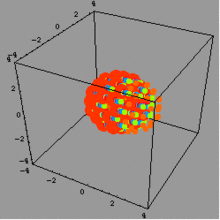Coulomb explosion

A Coulomb explosion is a mechanism for coupling electronic excitation energy from intense electromagnetic fields into atomic motion. The Coulombic repulsion of particles having the same electric charge can break the bonds that hold solids together. When done with a narrow laser beam, a small amount of solid explodes into a plasma of ionized atomic particles.
With their low mass, outer valence electrons responsible for chemical bonding are easily stripped from atoms, leaving them positively charged. Given a mutually repulsive state between atoms whose chemical bonds are broken, the material explodes into a small plasma cloud of energetic ions with higher velocities than seen in thermal emission.[1]
A Coulomb explosion is one particular mechanism that permits laser-based machining.
Coulomb explosions for industrial machining are made with brief (picosecond or high femtoseconds) laser pulses. The enormous beam intensities required (10–400 terawatt per square centimeter thresholds, depending on material)[citation needed] are only practical to generate, shape and deliver for very brief instants of time.
A Coulomb explosion is a "cold" alternative to the dominant laser etching technique of thermal ablation, which depends on local heating, melting, and vaporization of molecules and atoms using less-intense beams. Pulse brevity down only to the nanosecond regime is sufficient to localize thermal ablation – before the heat is conducted far, the energy input (pulse) has ended. Nevertheless, thermally ablated materials may seal pores important in catalysis or battery operation, and recrystallize or even burn the substrate, thus changing the physical and chemical properties at the etch site. In contrast, even light foams remain unsealed after ablation by Coulomb explosion.
Coulomb explosion etching can be used in any material to bore holes, remove surface layers, and texture and microstructure surfaces; e.g., to control ink loading in printing presses.[2]
See also
References
- ↑ Hashida, M.; Mishima, H.; Tokita, S.; Sakabe, S. (2009). "Non-thermal ablation of expanded polytetrafluoroethylene with an intense femtosecond-pulse laser". Optics Express 17 (15): 13116–13121. Bibcode:2009OExpr..1713116H. doi:10.1364/OE.17.013116.
- ↑ Mëller, D. (November 2009). "Picosecond Lasers for High-Quality Industrial Micromachining". Photonics Spectra: 46–47.